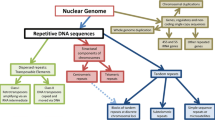Abstract
This study is an attempt to reconstruct the stages of the evolution of heterochromatin in eukaryotes. According to the hypothesis put forward in the work, the origin of satellite DNAs (stDNAs) was directly related to certain functional characteristics of DNA polymerases, and stDNAs themselves are products of accidental slippage at replication initiation sites. Even at the moment when the stDNAs precursors (protosatellites) appeared, they had properties of selfish DNA. Therefore, specific complex mechanisms of genetic control of their replication and recombination have developed in evolution to restrict the spread of these DNAs over the genome. The host control over protosatellites has led to the appearance of the main heterochromatic characteristics in them, such as late replication, decreased recombination, and denser chromatin packing compared to euchromatin. The next stage of heterochromatin evolution led to the union of protosatellite clusters and ordinary genes if late replication was necessary for these genes or if gene complexes already formed required protection from the destructure effect of crossing over. The known cases of location of certain genes in heterochromatic blocks in Drosophila melanogaster,the eukaryote that has been best studied genetically, confirm this hypothesis.
Similar content being viewed by others
REFERENCES
Beridze, T.G., Satellitnye DNK (Satellite DNAs), Moscow: Nauka, 1982.
Lindsley, D.L. and Zimm G.G., The Genome of Drosophila melanogaster, New York: Academic, 1992.
Gatti, M. and Pimpinelli, S., Functional Elements in Drosophila melanogaster Heterochromatin, Annu. Rev. Genet., 1992, vol. 26, pp. 239-275.
Kornberg, A., Sintez DNK (DNA Synthesis), Moscow: Mir, 1977.
Timsit, Y., DNA Structure and Polymerase Fidelity, J. Mol. Biol., 1999, vol. 293, pp. 835-853.
Orgel, L.E. and Crick, F.H.C., Selfish DNA: The Ultimate Parasite, Nature, 1980, vol. 284, pp. 604-607.
Lima-de-Faria, A. and Jaworska, H., Late DNA Synthesis in Heterochromatin, Nature, 1968, vol. 217, pp. 138-142.
Back, F., The Variable Condition of Euchromatin and Heterochromatin, Int. Rev. Cytol., 1976, vol. 45, pp. 25-64.
Borun, T.W., Scharff, M.D., and Robbins, E., Rapidly Labeled Polyribosome Associated RNA Having the Property of Histone Messenger, Proc. Natl. Acad. Sci. USA, 1967, vol. 58, pp. 1977-1987.
Wellauer, P.K. and Dawid, I.B., The Structural Organization of Ribosomal DNA in Drosophila melanogaster, Cell (Cambridge, Mass.), 1977, vol. 10, pp. 193-212.
Golubovsky, M.D., The Organization of the D. melanogaster Genome, Localization and Phenotypic Diversity of Mutations, Problemy genetiki v issledovaniyakh na drozofile (Genetic Problems in Studies with Drosophila), Khvostova, V.V., et al., Eds., Novosibirsk: Nauka, 1977, pp. 152-203.
Shalet, A., Exchanges at the bobbed Locus of Drosophila melanogaster, Genetics, 1969, vol. 63, pp. 133-153.
Procunier, J.D. and Tartof, K.D., A Genetic Locus Having Trans and Contiguous Cis Functions That Control the Disproportionate Replication of Ribosomal RNA Genes in Drosophila melanogaster, Genetics, 1978, vol. 88, pp. 67-79.
Author information
Authors and Affiliations
Rights and permissions
About this article
Cite this article
Bashkirov, V.N. The Origin of Heterochromatin in Eukaryotes. Russian Journal of Genetics 38, 656–658 (2002). https://doi.org/10.1023/A:1016039800920
Issue Date:
DOI: https://doi.org/10.1023/A:1016039800920




